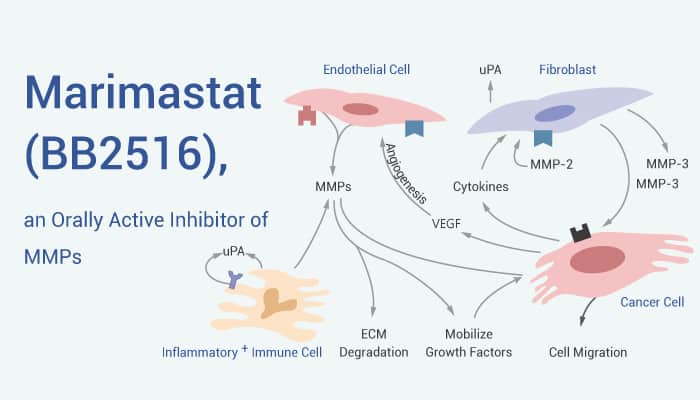Marimastat (BB2516) is a broad spectrum and orally bioavailable inhibitor of MMPs (Matrix metalloproteinases). Marimastat (BB2516) is an angiogenesis and metastasis inhibitor, which limits the growth and production of blood vessels. Besides, As an antimetastatic agent, it prevents malignant cells from breaching the basement membranes.
Marimastat (BB2516) shows potent broad-spectrum inhibitory activity against most of the major MMPs. That is, MMP-1, MMP-2, MMP-3, MMP-7, MMP-9 with IC50s of 5 nM, 6 nM, 230 nM, 16 nM, 3 nM, respectively. Besides, Marimastat (BB2516) shows good pharmacokinetics with a half-life of approximately 10 hr and a balanced excretion. As a result, approximately 75% was metabolized in the liver, and the remaining 25% was excreted unchanged via the kidney in healthy volunteers.
Marimastat (BB2516) is an angiogenesis and metastasis inhibitor.
 Marimastat (BB2516) (1-10000 nM) shows inhibition for VEGF (50 ng/ml) stimulated PECAM-1 positive capillary outgrowth in a dose-dependent manner. Furthermore, the experimental materials come from some 17-day-old fetal mouse metatarsal bone organ cultures. What’s more, Marimastat (BB2516) (1 μM) shows inhibition of vascular outgrowth. Furthermore, it also shows selectively angiogenesis effects. Besides, this compound shows anti-angiogenic properties in various in vitro models by interfering with endothelial cell invasion and proliferation.
Marimastat (BB2516) (1-10000 nM) shows inhibition for VEGF (50 ng/ml) stimulated PECAM-1 positive capillary outgrowth in a dose-dependent manner. Furthermore, the experimental materials come from some 17-day-old fetal mouse metatarsal bone organ cultures. What’s more, Marimastat (BB2516) (1 μM) shows inhibition of vascular outgrowth. Furthermore, it also shows selectively angiogenesis effects. Besides, this compound shows anti-angiogenic properties in various in vitro models by interfering with endothelial cell invasion and proliferation.
Moreover, Animals receiving chemoradiation and Marimastat (BB2516) (8.7 mg/kg) have statistically significant delayed growth, compared to animals receiving chemoradiation alone. Additionally, It indicates that marimastat (BB2516) may work in combination with chemotherapy and radiation to inhibit tumor growth.
In conclusion, Marimastat (BB2516) is a broad spectrum and orally bioavailable inhibitor of MMPs. Moreover, Marimastat (BB2516) also inhibits angiogenesis and metastasis.
Reference:
[1] Rasmussen HS, et al. Pharmacol Ther. 1997;75(1):69-75.
[2]. Yu M, et al. Chemistry Open. 2013 Jun;2(3):99-105.
[3]. van Wijngaarden J, et al. Biochem Biophys Res Commun. 2010 Jan 8;391(2):1161-5.
[4]. Skipper JB, et al. ORL J Otorhinolaryngol Relat Spec. 2009;71(1):1-5.